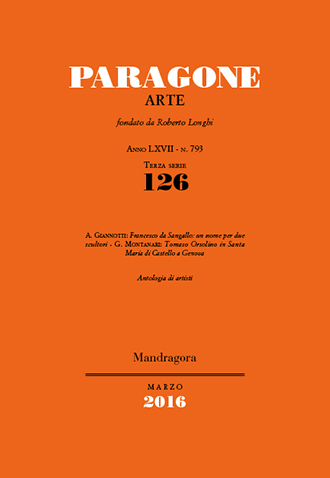Paragone Arte 126

Anno LXVII – Terza serie – Numero 126 (793) Marzo 2016
Alessandra Giannotti: Francesco da Sangallo: un nome per due scultori
Giacomo Montanari: Tomaso Orsolino in Santa Maria di Castello a Genova
ANTOLOGIA DI ARTISTI
Una conferma per il Maestro di San Sisto (Daniele Guernelli)
SUMMARY
ALESSANDRA GIANNOTTI
This is the first account of Francesco di Vincenzo Baccelli da Sangallo, hitherto confused with the better-known Francesco di Giuliano Giamberti da Sangallo. This gives coherent form to the latter’s style and biography, ridding his oeuvre of the traditional and incorrect attributions of earlier scholarship, which belong instead to the partly homonymous artist: three narrative scenes from the marble revetment of the Holy House of Loreto, some small putti from the same decorative project, and – in all likelihood – some elements of the interior of the New Sacristy in San Lorenzo, Florence. The article seeks to clarify Baccelli’s evolution during the 1520s in Rome, Florence and the Tyrrhenian coast, in the shadow of Michelangelo, in contact with the workshop of Bartolomé Ordóñez in Versilia, and subsequently within the circle of Niccolò Tribolo and Raffaello da Montelupo, with whom he had collaborated professionally in Loreto.
GIACOMO MONTANARI
The innovative naturalistic qualities in the portrait of the Genoese physician Demetrio Canevari, carved by the sculptor Tomaso Orsolino in 1626-1627 for his cenotaph in the church of Santa Maria di Castello in Genoa, cast new light on early adherence to Roman sculptures of the early 1600s in Liguria. Bearing in mind how the preparatory drawing, dated 7 May 1626, differs from the finished work, and how high-level patronage was aware of the latest artistic and cultural developments in Rome – where Demetrio had been active throughout his life, at Santa Maria sopra Minerva – the Canevari monument can now be identified as a significant and early precursor to the Baroque innovations of the later seventeenth century, which remained dormant and not entirely understood or reiterated for about forty years.
DANIELA GUERNELLI
The article presents a new manuscript attributable to the Master of San Sisto, a recently-identified artist who is distinct from the Second Master of the Antiphonal M of San Giorgio Maggiore in Venice. These anonymous illuminators, strongly influenced by the art of Belbello da Pavia, appear to have belonged to the Benedictine Congregation of Santa Giustina. The codex attributed here is an Italian translation of Gregory the Great’s Moralia in Job, now housed in the Biblioteca Nazionale in Rome (ms. Vitt. Em. 237), and illustrates the style of this Master, who worked in the Po Valley area during the 1460s and 1470s.
